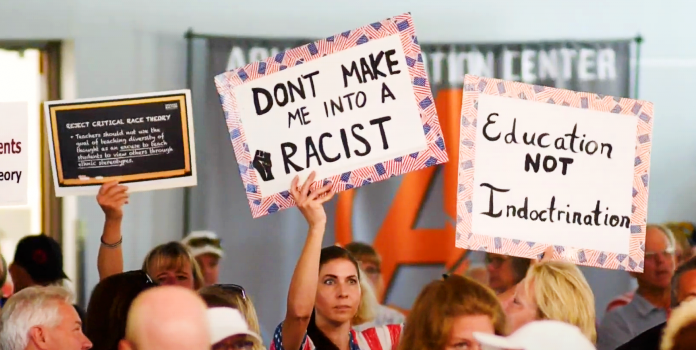(John Ransom, Headline USA) The Florida Department of Education (FLDOE) today gave examples of Critical Race Theory (CRT) in math textbooks that they say contributed to the rejection of the books.
One of the examples highlights the dangers of CRT, including its questionable scholarship, and the highly charged political atmosphere it creates even in liberal academia.
“More than 2 million people have tested their racial prejudice using an online version of the Implicit Association Test. Most groups’ average scores fall between ‘slight’ and ‘moderate bias, but the differences among groups by age and political identification, are intriguing,” the math problem states, in an example shared by the New York Post.
The example showed the breakdown of what the textbook said was implicit bias on race by age group, and by political ideology.
.@GovRonDeSantis signs ‘Stop W.O.K.E. Act’ targeting #CRT as legal challenge looms
Reporting by @RenzoDowneyhttps://t.co/qF7J3QD6mq#FlaPol pic.twitter.com/7K2DvvlKeK
— Florida Politics (@Fla_Pol) April 22, 2022
For years however, critics of the Implicit Association Test (IAT) shared by the book, including liberal critics and the test creators themselves, have warned that there are limitations to the test, which highlights the point that incorporating CRT into textbooks only includes results that CRT proponents want.
In fact, there’s a growing body of research that says IAT doesn’t do what it’s billed to do.
“The IAT, this research suggests, is a noisy, unreliable measure that correlates far too weakly with any real-world outcomes to be used to predict individuals’ behavior — even the test’s creators have now admitted as such,” said New York Magazine.
In short, the IAT, which is supposed to measure bias, produces biased results.
What is more is that researchers who have criticized IAT, have come under such intense, personal and political attack, that they don’t even want to talk about the subject anymore.
“I appreciate your interest but I’m mostly trying to extricate myself from that debate — it’s genuinely unpleasant,” Hart Blanton, a University of Connecticut researcher who has criticized the IAT, told left-wing Vox when contacted about his criticism of IAT.
And that highlights what we have already seen about the CRT debate.
Now, after several years of being introduced stealthily into public school curriculum, we don’t even have to imagine what CRT might do to lesser schools such as elementary, middle and high school, if it can’t be handled maturely at the university level.
The FLDOE released four examples of CRT in action, including the IAT question, in response to criticism when it rejected 54 proposed textbooks that included banned subjects like CRT, Social Emotional Learning and Common Core, said the New York Post.

